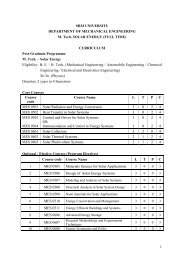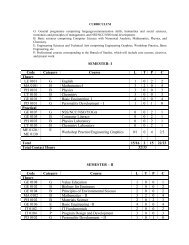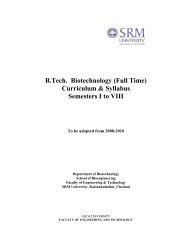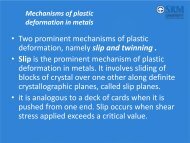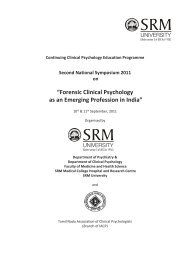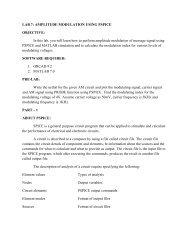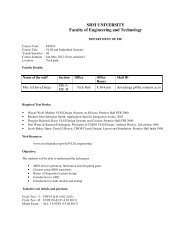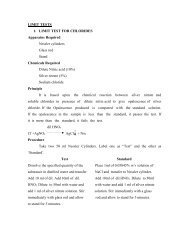Pharmacoeconomics: Applications from the "Real World"
Pharmacoeconomics: Applications from the "Real World"
Pharmacoeconomics: Applications from the "Real World"
Create successful ePaper yourself
Turn your PDF publications into a flip-book with our unique Google optimized e-Paper software.
CHAPTER:3<br />
<strong>Applications</strong> of <strong>Pharmacoeconomics</strong><br />
BY<br />
Mrs. K.SHAILAJA., M. PHARM.,<br />
LECTURER<br />
DEPT OF PHARMACY PRACTICE,<br />
SRM COLLEGE OF PHARMACY
PE <strong>Applications</strong><br />
• To provide pharmacoeconomics and outcomes research, education, and<br />
consulting services to assess <strong>the</strong> value of pharmaceutical products and services<br />
in today’s healthcare systems.<br />
• Summary of Services:<br />
• Research services<br />
– customized PE and OR studies<br />
– site or population-specific economic models<br />
– partnerships with HC organizations<br />
• Educational services<br />
– PE lectures and workshops<br />
– PE educational materials<br />
• Consulting services<br />
– protocol design and strategic PE plans
Primary PE <strong>Applications</strong><br />
Drug Therapy<br />
Evaluations<br />
Justify Pharmaceutical<br />
Care Services
Potential Hurdles for Application of PE to<br />
Drug Decision-Making<br />
• Lack of “PE sophistication” by target audience (e.g.<br />
hospital administrators, MC pharmacy directors)<br />
• Lack of “PE sophistication” by pharmacy practitioners<br />
who are generating and/or interpreting PE data<br />
• Lack of organizational resources (time and $$)<br />
• Component vs. system management approach<br />
• Budget responsibilities<br />
• “Silo” mentality
HOW <strong>Pharmacoeconomics</strong> is<br />
Applied in <strong>the</strong> <strong>Real</strong> World
Strategies for Putting Theory into<br />
Practice<br />
Strategy 1:<br />
Interpret, critique, and use results <strong>from</strong> studies<br />
published in <strong>the</strong> literature<br />
Strategy 2:<br />
<br />
Utilize economic modeling<br />
Strategy 3:<br />
Conduct a local observational PE evaluation
Factors to Consider When Selecting an<br />
“Application Strategy”<br />
What is <strong>the</strong> PE question being asked?<br />
What is <strong>the</strong> timeframe for <strong>the</strong> decision?<br />
What are <strong>the</strong> resources and data sources available?<br />
What is <strong>the</strong> impact of <strong>the</strong> decision on organizational<br />
costs and quality of care?
Scale for Selecting a PE Application Strategy<br />
(Potential Impact of Decision on Cost And Quality)<br />
None Mild Moderate Extreme<br />
Compare<br />
acquisition<br />
costs<br />
Review PE literature,<br />
conduct sensitivity<br />
analysis<br />
Perform<br />
economic<br />
modeling<br />
Conduct<br />
retrospective<br />
study<br />
Conduct<br />
prospective<br />
study<br />
(Application Strategy)
Strategy 1: Use <strong>the</strong> Literature<br />
ADVANTAGES<br />
Data often plentiful<br />
Quick<br />
Inexpensive<br />
Subject to peer-review<br />
Variety of results can be<br />
examined<br />
Results <strong>from</strong> RCT<br />
DISADVANTAGES<br />
Results <strong>from</strong> RCT (costs<br />
may be protocol driven)<br />
External validity<br />
Placebo-controlled<br />
Misuse of PE terms<br />
Variations in quality of<br />
studies published
Strategy 2: Use Economic Modeling<br />
ADVANTAGES<br />
Inexpensive<br />
Quick<br />
Yields organization-specific<br />
results<br />
Bridges efficacy to<br />
effectiveness<br />
Data collection is unobtrusive<br />
Increased ability to generalize<br />
results<br />
DISADVANTAGES<br />
Results dependent on<br />
assumptions<br />
Potential for researcher bias<br />
Controversial<br />
Reluctance of decisionmakers<br />
to accept results<br />
May require a meta-analysis<br />
of <strong>the</strong> literature
Strategy 3: Conduct a Local<br />
Observational Study<br />
ADVANTAGES<br />
Flexible<br />
Yields provider-specific data<br />
Reflects “usual care” or<br />
effectiveness<br />
Usually offer comparative data<br />
Data <strong>from</strong> multiple sources can<br />
be used<br />
Are less expensive than RCT<br />
DISADVANTAGES<br />
Expensive (time and $)<br />
Difficult to control and<br />
randomize<br />
Potential for patient selection<br />
bias<br />
Small sample size<br />
May be difficult to generalize<br />
results to o<strong>the</strong>r patient<br />
populations and providers
Source Advantages Disadvantages<br />
RCT<br />
Additional PE Data Sources<br />
Measure efficacy<br />
Well controlled<br />
Powered to detect statistically<br />
significant differences<br />
Offer sufficient sample size<br />
Collect prospective data<br />
Do not reflect “usual care”<br />
Results may be difficult to<br />
generalize<br />
Not usually comparative<br />
Not usually powered to detect<br />
QoL or Economic differences<br />
Time-consuming & expensive<br />
Database<br />
studies<br />
Have large sample size potential<br />
Can provide data quickly<br />
Are reflective of “usual care”<br />
Differ in quality of databases<br />
Use on inconsistent coding<br />
Expert<br />
opinions<br />
Are inexpensive<br />
Can provide missing data quickly<br />
Are reflective of usual care<br />
Can adjust to protocol-driven<br />
resource use<br />
Have potential for bias<br />
Are controversial<br />
Potential for large variations




